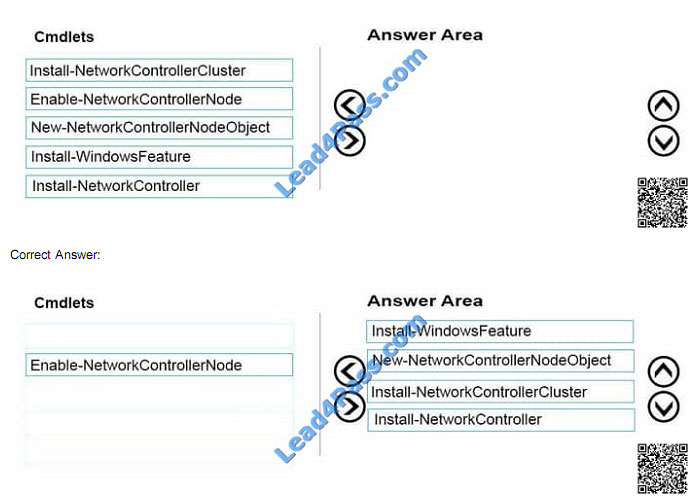Upgrading Your Skills to MCSA: Windows Server 2016: 70-743 exam. Share the latest 70-743 dumps and Practice test questions for free. Real and effective exam questions and answers. 70-743 pdf online Download, 70-743 YouTube video online learning to improve skills! Examthings share 40 Practice test questions for FREE! Get the full 70-743 exam dumps: https://www.leads4pass.com/70-743.html (Total questions:252 Q&A)
[PDF] Free Microsoft MCSA 70-743 pdf dumps download from Google Drive: https://drive.google.com/open?id=1Yk774y3D4bGhY6cVajAvHB_pWLXjOf0x
[PDF] Free Full Microsoft pdf dumps download from Google Drive: https://drive.google.com/open?id=1AwBFPqkvdpJBfxdZ3nGjtkHQZYdBsRVz
Exam 70-743: Upgrading Your Skills to MCSA: Windows Server 2016: https://www.microsoft.com/en-us/learning/exam-70-743.aspx
Latest effective Microsoft MCSA 70-743 Exam Practice Tests
QUESTION 1
Note: This question is part of a series of questions that use the same or similar answer choices. An answer choice may
be correct for more than one question in the series. Each question is independent of the other questions in this series.
Information and details provided in a question apply only to that question.
You have a two-node Hyper-V cluster named Cluster1.
A virtual machine named VM1 runs on Cluster1.
You need to configure monitoring of VM1. The solution must move VM1 to a different node if the Print Spooler service
on VM1 stops unexpectedly.
Which tool should you use?
A. the clussvc.exe command
B. the cluster.exe command
C. the Computer Management snap-in
D. the configurehyperv.exe command
E. the Disk Management snap-in
F. the Failover Cluster Manager snap-in
G. the Hyper-V Manager snap-in
H. the Server Manager app
Correct Answer: F
QUESTION 2
You have a server named Server1 that runs Windows Server 2016.
You need to deploy the first cluster node of a Network Controller cluster.
Which four cmdlets should you run in sequence? To answer, move the appropriate cmdlets from the list of cmdlets to
the answer area and arrange them in the correct order.
Select and Place:
QUESTION 3
Note: This question is part of a series of questions that present the same scenario. Each question in the series contains
a unique solution. Determine whether the solution meets the stated goals. Refer to exhibit:

Server1 has two virtual machines named VM1 and VM that run Windows Server 2016. VM1 connects to Private VM2
has two network adapters.
You need to ensure that VM1 connects to the corporate network by using NAT.
Solution: You connect VM2 to private1 and External1. You run the New-NetNatIpAddress and the New-NetNat cmdlets
on VM2. You configure VM1 to use VM2 as the default gateway.
Does this meet the goal?
A. Yes
B. No
Correct Answer: B
QUESTION 4
Your network contains an Active Directory forest named contoso.com. The forest contains a member server named
Server1 that runs Windows Server 2016. Server1 is located in the perimeter network. You install the Active Directory
Federation Services server role on Server1. You create an Active Directory Federation Services (AD FS) farm by using
a certificate that has a subject name of sts.contoso.com.
You need to enable certificate authentication from the Internet on Server1.
Which two inbound TCP ports should you open on the firewall? Each correct answer presents part of the solution.
A. 389
B. 443
C. 3389
D. 8531
E. 49443
Correct Answer: BE
Configuring the following network services appropriately is critical for successful deployment of AD FS in your
organization: Configuring Corporate Firewall References: https://technet.microsoft.com/en-
us/library/dn554247(v=ws.11).aspx https://technet.microsoft.com/en-us/windows-server-docs/identity/ad-fs/design/ad-fs-
requirements#BKMK_7
QUESTION 5
You have a server named VM1. VM1 is a virtual machine on a Hyper-V host that runs Windows Server 2016.
You need to create a checkpoint that includes the virtual machine memory state of VM1.
What commands should you run? To answer, select the appropriate options in the answer area.
Hot Area:

QUESTION 6
You have a server that runs Windows Server 2016.
The server contains a storage pool named Pool1. Pool1 contains five physical disks named Disk1, Disk2, Disk3, Disk4,